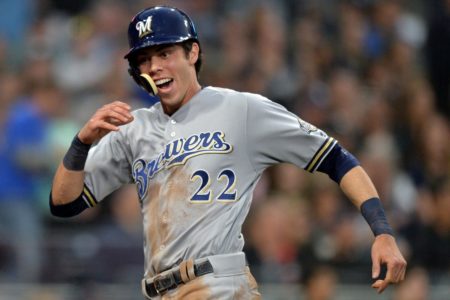Hot Stove Thoughts about Player Movements in Baseball
 From Harry Frazee to New York, with Love
From Harry Frazee to New York, with Love
There’s something to be said for the originality and creativity of player movement in baseball which incubates philosophical investigation. No other sport can match the impassioned player movements each hot stove season.
But one of the earliest baseball trades is still considered the most famous of them all. And it was a sale. Made by a theatrical agent, not a fan of Babe Ruth’s theatrical antics. Harry Frazee opted for the Babe Ruth deal of 1920 because he was enamored of the Yankees endless pile of greenery.
The deal was simple, expensive (as it should’ve been for a player of Ruth’s ilk), and powered by money. Harry Frazee was always in need of more capital to finance and expand his theatrical empire. So, the sale of Ruth involved an initial payment of $25,000 in 1920 plus a $300,000 loan (guaranteed by the security of Fenway Park itself) and then payments of $25,000 each of the next three years.
A handshake later, Babe Ruth was a Yankee.
At the time there was a power struggle in the American League, and League President Bancroft “Ban” Johnson had made it expressly clear he wanted Frazee to trade with the “Loyal Five” (the teams loyal to Johnson), not the “Insurrectos,” as the Yankees, Red Sox, and the Chicago White Sox were known.
But Frazee was of the same mind as the other two “Insurrecto” owners and thumbed his nose at Johnson. Just as he had done months earlier when he completed his first trade with the Yankees, receiving two players and, more importantly, $40,000 in cash from Jacob Ruppert for one of his better pitchers, Carl Mays, who had bolted the Sox and demanded a trade.
Ban Johnson wanted Mays suspended. Frazee ignored him. Then Johnson ordered Frazee to trade Mays to one of the “Loyal Five.” Frazee ignored this demand, and traded Mays to the Yankees.
As this happened, Ban Johnson was not only watching the balance of power shift in his American League but the gradual diminishment of his authority. The rise of the Yankees (now flush with the best ex-Boston Red Sox talent which served as the foundation for their first three World Series championships in the 1920s) and the dismantling of the Boston Red Sox team that had won four World Series titles between 1912 and 1918 had begun. By the time Frazee had sold the Red Sox in 1923, he had added almost half a million Yankee dollars to his theatrical empire.
The next owner of the Red Sox purchased a bare bones squad that would finish last the following nine seasons until Tom Yawkey bought the team in 1933. So much for Frazee’s love of baseball. (See Harry Frazee and the Red Sox for a thorough discussion of the topic).
Why Teams Are Not Trading Superstars Today
The game has changed. The demise of the Reserve Clause and the corrupting influence of television dollars have radically altered the mechanics of the game. The game itself almost doesn’t matter, because of all the guaranteed money. Eyeballs matter. Although MLB wants to speed the product up, lest the networks decide the games are too expensive and decide to cut future payments to the owners.
Ouch.
So, players are now considered entertainment products.
Their value now equals on-the-field production and merchandise and promotional appeal, as well as the drawing power of the player. Signing Dallas Keuchel this off season might help the Yankees win a few more games next season, but signing Manny Machado, which might cost more than $30 million per year, makes business sense. He will increase the attractiveness of the product, increase the Latino viewing market and could add more merchandising dollars to the team than his cost per season, despite the player weaknesses the past World Series exposed.
Without the Reserve Clause, over the past half century player movements have assumed a different dynamic. Players are now evaluated based on how much time they have remaining on their free agency clocks and their attractiveness as promotional chips. (Leaving aside the analytics of their performance in this discussion.)
Which is why the dearth of superstars in baseball is such an issue. Because just as A-list stars open movies in Hollywood and football games are hyped for the battle of the quarterbacks, how can baseball hype its product? Who are the A-list stars?
Since the 1970s and free agency, players have become movable assets, not fixed assets as they had been under the Reserve Clause. Ownership is not only purchasing baseball skills, but the latent promotional and marketing value of the player. And a great player is worth millions—and millions more if he delivers and the team makes the revenue-rich post-season.
So, teams don’t move players unless they have to (witness the Mets’ refusal to trade any of their pitching assets this past season despite public pressure to do so).
The Free Agency Clock
Teams now evaluate players based on time remaining on their six-year contractual cycles. If a player has not been moved before they have reached “Rental Player” status (meaning the player is an entirely movable asset whose control is about to expire so there is only minimal remaining value), then the team loses almost the complete value of the player.
When Baltimore finally traded Manny Machado to the Dodgers as a “rental” in July this past season, they received limited value for his contract.
Within the structure of free agency, Mike Trout agreed to his first long-term contract at 24—three years before free agency. The Los Angeles Angels bought out his arbitration eligibility and his first three free agency seasons. Once the contract expires in two years, Trout can play for any other team and as a Hall of Fame caliber player will certainly receive offers, though length of contract will be an issue.
Christian Yelich and Jose Ramirez signed team-friendly contracts. Though unlike Trout, who had more leverage because of his incredible production, their contracts are well-below market for their skills and achievements. But they earned more money than they would have during their arbitration-eligible seasons. They accepted the trade-off: more now, less later.
Mike Trout should be an A-list player. But on a bad team, baseball is not realizing his full value as an A-list property. Any good team he would join would automatically be considered a front runner to win the World Series. As long as Trout remains on a second division team, there’s little excitement surrounding his stellar performance. No buzz.
In today’s baseball world great players are not traded. Ownership across the sport is so wealthy that they do not need the few million dollars the player would return. Young prospects are a different story. But teams jealously guard their young prospects.
A player like Trout, with two years of control remaining would only be traded if the Angels believed they could not win during his window of control—or they are overwhelmed by an offer. More than likely, the Angels make substantial money with Trout on their marketing and broadcast operations. Even if they don’t win, why trade him?
The Angels, like most teams, own or control their own broadcasts and receive the lion’s share of revenues from them. Players (especially exceptional ones like Trout) have more value as a name on the marquee than as a trade chip.
So something like selling Babe Ruth no longer makes economic sense, if it ever did. The difference was that Babe Ruth played under the Reserve Clause and could never “play out” his contract. Even at the end of his career in 1935, the Yankees traded him rather than release him.
In two years, Mike Trout will regain control over his career. His six-year contract will expire and he will be a free agent. Babe Ruth never enjoyed this luxury. Even after his last few games he retired the property of the Boston Braves.
























